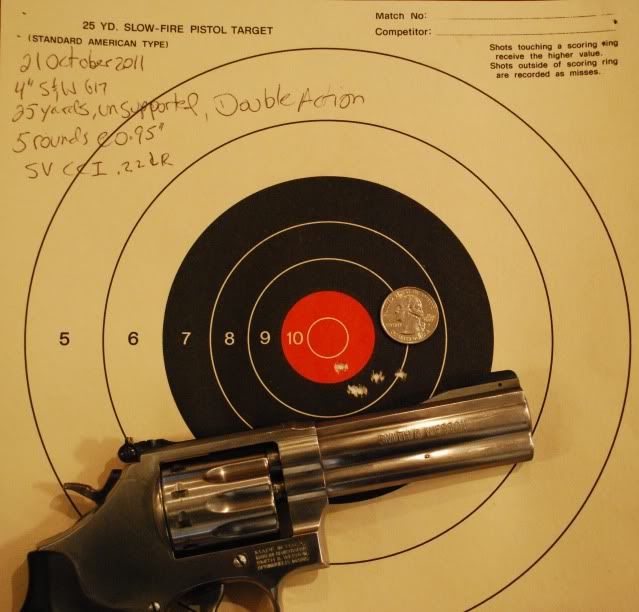Wow. Great post and question. I got into shooting relatively recently and late in life and still consider myself a student, so I always preface my remarks with "I'm no expert on the matter". Nonetheless, what I've done has worked well for me, so I'll pass on my thoughts & experience.
First, it's
all about the fundamentals: Sight picture and trigger control. Consistently, for
every shot. Those who've been shooting a while may find it boring, but spending quality time dry firing (
quality dry fire) and simply shooting groups on an appropriate bullseye-type target pays big dividends. Get to the point where you can
consistently shoot excellent groups before doing anything fancy, like trying to shoot fast. It'll take many thousands of rounds, so I'd advise just using a .22. A good .22 and good ammo. I spend my first 2-3
years doing
nothing but this. Below is a picture of the rimfire ammo I saved during this time. One of my great advantages was that, as a new shooter, I didn't know how boring this was considered, but in retrospect, it paid
huge dividends.
With a rifle, I'd recommend an accurate .22
bolt rifle (e.g. Savage or CZ), a decent scope and good ammo the rifle likes. Shoot from a bench with a good solid support (e.g. front & rear bag). Just shoot groups, focusing on sight picture and trigger control and nothing else. Some will argue you need to get off the bench, and while I agree, there's time for that later. Right now, this setup allows you to isolate your shooting to sight picture and trigger control. I'd use an NRA smallbore target, and keep track of your scores and your group size. Under these conditions, I think you should be able to eventually get all 5 rounds consistently inside the 0.9" 10-ring at 50 yards.
If a handgun is more your interest, get yourself a decent .22 and ammo it likes. Don't waste your time and money on a plinking .22. Get a decent one. A Ruger MkIII with a 5.5" bull barrel would be perfect. If you've got the money, a S&W Model 41 would be pretty sweet. And if you've got the money, consider getting a S&W 617 revolver, and shoot it in double action. Shooting a DA revolver well in DA takes a lot of practice, but it'll teach you more about sight picture and trigger control than a semi-auto, IMO. Get the DA trigger down and your transition to most everything else will be pretty easy. Can't say the same about the other direction.
For a handgun, use NRA bullseye targets. Shoot at 15 or 25 yards. You can find some printable 15-yard reduced targets online. Again, keep track of your score and group size. As far as group size, it's my personal opinion that a good (but not excellent) shooter can shoot
honest and
consistent 3" 5-shot groups at 25 yards with a service-sized handgun. Revolver shooters ought to be able to do this in double action. 3@25 is far and away better than anything you'll likely see at your local range, but it's not world class, yet it's very do-able with a bunch of practice.
Regarding plinking: Forget it. Remove it from your practice repertoire. Until you've mastered the fundamentals (which we never really do), it just re-inforces bad habits.
The mental game is a
huge part of shooting well. Understand that now and practice that as much as your gun skills, and it'll amplify your progress greatly. Blow it off, and you'll plateau well before you reach your potential. A great book to read on the matter is Lanny Bassham's
With Winning in Mind.
A word on competition: Some might advise you to start formally competing in target events, as there's nothing like competition to up your game and keep you motivated. I agree that competition's great for this, and I compete myself, but I also happen to think, based on my experience, that it's better to get the fundamentals mastered on your own before competing. Why? Because once you start competing, you begin to formulate a self-image based on your match performance. Your match performance at first won't be very good, so neither will your self-image as a shooter. Your self-image begins to solidify quickly, so you begin to subconsciously believe you're "just" a marksman, sharpshooter, etc, and that's where you'll plateau. I've seen it many, many times. Get the fundamentals down before you start competing, and you'll rise through the ranks quicker than you can solidify a negative self-image. Your self-image will, in fact, be that you're a winner, which further helps your shooting.
Anyhow, hope some of this helps.
Saved rimfire ammo from my first couple years. I started with a .22 rifle, then transitioned to a .22 revolver. I estimate there are about 40k cases in this box:
The result...


